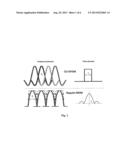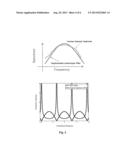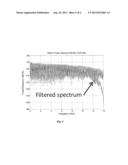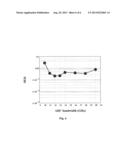Patent application title: NYQUIST WAVELENGTH DIVISION MULTIPLEXING SYSTEM
Inventors:
Zhensheng Jia (Morganville, NJ, US)
Zte (usa) Inc.
Zhensheng Jia (Morganville, NJ, US)
Jianjun Yu (Basking Ridge, NJ, US)
Jianjun Yu (Basking Ridge, NJ, US)
Hung-Chang Chien (Bridgewater, NJ, US)
Hung-Chang Chien (Bridgewater, NJ, US)
Assignees:
ZTE (USA) INC.
IPC8 Class: AH04J1402FI
USPC Class:
398 79
Class name: Optical communications multiplex wavelength division or frequency division (e.g., raman, brillouin, etc.)
Publication date: 2013-08-29
Patent application number: 20130223843
Abstract:
Aspects of the present invention include apparatus and methods for
transmitting and receiving signals in communication systems. A beam
splitter splits an optical signal into a plurality of signals. At least
one QPSK modulator generates a plurality of QPSK modulated signals from
the plurality of signals. An optical multiplexer combines the plurality
of QPSK modulated signals into a multiplexed signal. The multiplexed
signal is then transmitted.Claims:
1. A method of transmitting an optical signal, the method comprising:
splitting the optical signal into a plurality of signals; generating, by
at least one Quadrature Phase Shift Key (QPSK) modulator, a plurality of
QPSK modulated signals; combining, by an optical multiplexer, the
plurality of QPSK modulated signals into a multiplexed signal; and
transmitting the multiplexed signal.
2. The method of claim 1 wherein the QPSK modulator comprises cascaded modulators.
3. The method of claim 1, wherein the combining comprises spectrum shaping and multiplexing the plurality of QPSK modulated signals.
4. The method of claim 1, wherein the optical multiplexer is a wavelength-selective switch (WSS) filter.
5. A method for receiving signals in an optical communication system comprising: demultiplexing a received multiplexed signal to demultiplexed signals; and coherently detecting the demultiplexed signals.
6. The method of claim 5, wherein the coherently detecting comprises realizing chromatic dispersion compensation.
7. The method of claim 5, wherein the coherently detecting comprises post-filtering equalized signals.
8. The method of claim 7, wherein the coherently detecting comprises maximum likelihood sequence estimating the post-filtered equalized signals.
9. An apparatus for transmitting an optical signal, the method comprising: means for splitting a signal into a plurality of signals; means for generating a plurality of QPSK modulated signals; means for combining the plurality of QPSK modulated signals into a multiplexed signal; and means for transmitting the multiplexed signal.
10. The apparatus of claim 9 wherein the means for combining comprises means for spectrum shaping and means for multiplexing the plurality of QPSK modulated signals.
11. A system for transmitting an optical signal, the system comprising: a beam splitter configured to split the optical signal into a plurality of signals; at least one Quadrature Phase Shift Key (QPSK) modulator configured to generate a plurality of QPSK modulated signals; an optical multiplexer configured to combine the plurality of QPSK modulated signals into a multiplexed signal; and a fiber configured to transmit the multiplexed signal.
12. The system of claim 11, wherein the QPSK modulator comprises cascaded modulators.
13. The system of claim 11, wherein the optical multiplexer is configured to spectrum shape and multiplex the plurality of QPSK modulated signals.
14. The system of claim 11, wherein the optical multiplexer is a wavelength-selective switch (WSS) filter.
Description:
CROSS-REFERENCE TO RELATED APPLICATIONS
[0001] This application claims priority to U.S. provisional application No. 61/604,978 which was filed on Feb. 29, 2012.
FIELD OF THE INVENTION
[0002] The field of the present invention is communication systems, and particularly, Nyquist wavelength division multiplexing (WDM).
BACKGROUND
[0003] As the traffic in communication systems continues to grow rapidly, particularly for video, mobile data, and cloud services, advanced modulation formats offering higher spectral efficiency (SE), such as 16 QAM have been considered to increase the total fiber capacity to meet the demand. However, higher modulation orders increase an implementation penalty and decrease receiver sensitivity, resulting in a higher required optical signal to noise ratio (OSNR). To avoid this higher requirement, another approach SE in WDM systems is to reduce the channel spacing between the individual channels, by either relying on orthogonality among neighboring channels in frequency domain (Coherent Optical OFDM) or in time domain (Nyquist WDM).
[0004] The CO-OFDM may require a larger receiver bandwidth and a higher analog-to-digital converter (ADC) sampling rate than Nyquist WDM. However, Nyquist WDM shows a more robust performance in terms of practical implementation. FIG. 1 shows the two technologies. It would be advantageous to implement a Nyquist WDM transmission system with coherent detection.
SUMMARY OF THE INVENTION
[0005] Aspects of the present invention employ Nyquist WDM to transmit signals realizing high-spectral efficiency over long distances.
[0006] In one aspect of the present invention include apparatus and methods for transmitting and receiving signals in communication systems. A beam splitter splits an optical signal into a plurality of signals. At least one QPSK modulator generates a plurality of QPSK modulated signals from the plurality of signals. An optical multiplexer combines the plurality of QPSK modulated signals into a multiplexed signal. The multiplexed signal is then transmitted.
BRIEF DESCRIPTION OF THE DRAWINGS
[0007] FIG. 1 illustrates an example of Coherent Optical Orthogonal Frequency Division Multiplexing (OFDM) and Nyquist WDM.
[0008] FIG. 2 illustrates a Nyquist WDM transmission system with coherent detection according to aspects of the present invention.
[0009] FIG. 3 illustrates a digital signal processing process according to aspects of the present invention.
[0010] FIG. 4 illustrates a signal spectrum before and after filtering.
[0011] FIG. 5 shows experimental validation results describing that an ADC as small as 12-13 GHz bandwidth for coherent detection in 28 Gbaud PDM QPSK signals over 25 GHz optical spacing.
[0012] FIG. 6 shows a digital filter, MLSE decoding and an inverse channel response according to aspects of the present invention.
DETAILED DESCRIPTION OF EMBODIMENTS
[0013] Aspects of the present invention employ Nyquist WDM to transmit signals realizing high-spectral efficiency over long distances.
[0014] FIG. 2 illustrates a schematic diagram of a transmitter and receiver according to aspects of the present invention. A laser 101 generates a continuous lightwave. The laser 101 may be a distributed feedback type laser diode DFB-LD, which may have a wide line width. For a 100 Gbit/s QPSK, a line width smaller than 2 MHz is sufficient. Although line widths greater than 2 MHz may also be sufficient. Alternatively, the laser source 101 may be a tunable external laser with a narrow line width and low phase noise which may be preferred for high level modulation format signals. The lightwave is split by a polarization beam splitter (PBS), of which each is modulated by a quadrature phase shift keying (QPSK) optical modulator. These modulated lightwaves are then combined by a polarization beam combiner (PBC) to realize polarization multiplexed QPSK modulated signals. This non-return-zero (NRZ)--QPSK modulation may be realized by cascaded serial or parallel modulators. Different modulation format modulators may also be used, such as 8 PSK, 8 QAM or a higher level modulator. Then an optical multiplexer 103 with a narrow-band optical filtering function may be used to perform aggressive spectrum shaping and multiplexing to obtain a Nyquist (symbol bandwidth=channel spacing) or faster-than Nyquist WDM signals (symbol bandwidth<channel spacing). This optical multiplexer 103 may be a WSS (wavelength-selective switch) filter which may be used for a few channels, a tunable optical filter, which may be used for one channel, an optical interleaver which may be used for WDM channels, or Fiber Bragg grating, which may be used for one channel. A transmission link 104 may be uncompensated for chromatic dispersion consisting of an optical amplifier (OA) and fiber at each span. The optical amplifier may be an erbium doped fiber amplifier (EDFA), a Raman amplifier, or the like. The optical fiber any various type of fiber, such as G.652 or a G.655 fiber.
[0015] After transmission of the signals, an optical demultiplexer 105 may demultiplex the WDM channels and route them for coherent detection. The optical demultiplexer 105 may be a WSS filter, which may be used for a few channels, a tunable optical filter, which may be for one channel, an optical interleaver, which may be used for WDM channels, or a Fiber Bragg grating, which may be used for one channel. At the receiver, a coherent detection technique employs a local oscillation (LO) signal after the PBS is launched into the 90° optical hybrid 106 with polarization split incoming transmitted signal. The diversified signals are sent to a photodiode (PD) 107 and digitally sampled with an analog-to-digital converter (ADC) 108. As shown in FIG. 3, a digital signal processing (DSP) unit 109 then compensates the front end 106 and 107 and retiming 108, and equalizes the static and dynamic linear impairments. The DSP unit includes re-sampling and clock recovery, linear chromatic dispersion compensation in time or frequency domain, constant modulus algorithm for adaptive polarization demultiplexing, polarization mode dispersion, and residual chromatic dispersion. The following carrier recovery may be to compensate for the frequency offset and carrier phase noise.
[0016] A digital filter may be added CMA and carrier phase recovery. The digital filter performs the function of removing a part of the high-frequency components in the signal spectrum, which relaxes the bandwidth requirement of the ADC and PD. This additional digital filter and maximum likelihood sequence estimation (MLSE) algorithms are used to suppress noise and crosstalk to realize optimum detection 110 in strong filtering channels in a Nyquist WDM. The required ADC bandwidth may be reduced to realize optimal detection. FIG. 4 shows the ideal filter shape having an inverse channel response after the regular DSP unit, like the cosine-type filter. The bandwidth requirement of a photodiode may also be reduced. The filtered spectrum is shown in FIG. 5. The experimental results are shown in FIG. 6. It can by seen that around half of the strong filter bandwidth may be need for sufficient performance. This is because the employment of a digital filter after a DSP unit removes the high-frequency components of a processed channel.
[0017] It should be understood that the methods and devices of the present invention may be executed employing machines and apparatus including simple and complex computers. Moreover, the architecture and methods described above can be stored, in part or in full, on forms of machine-readable media. For example, the operations of the present invention could be stored on machine-readable media, such as magnetic disks or optical disks, which are accessible via a disk drive (or computer-readable medium drive). Alternatively, the logic to perform the operations as discussed above, could be implemented in additional computer and/or machine readable media, such as discrete hardware components as large-scale integrated circuits (LSI's), application-specific integrated circuits (ASIC's), firmware such as electrically erasable programmable read-only only memory (EEPROM's); and the like. Implementations of certain embodiments may further take the form of machine-implemented, including web-implemented, computer software.
[0018] While aspects of this invention have been shown and described, it will be apparent to those skilled in the art that many more modifications are possible without departing from the inventive concepts herein. The invention, therefore, is not to be restricted except in the spirit of the following claims.
User Contributions:
Comment about this patent or add new information about this topic:
| People who visited this patent also read: | |
| Patent application number | Title |
|---|---|
| 20210191591 | INTEGRATED CIRCUIT AND TIMING CONTROLLER FOR DRIVING PANEL |
| 20210191590 | TOUCH SENSING DEVICE |
| 20210191589 | CAPTURING AND SENDING MULTIMEDIA AS ELECTRONIC MESSAGES |
| 20210191588 | Devices and Methods for Interacting with an Application Switching User Interface |
| 20210191587 | OPERATION TARGET SWITCHING APPARATUS, OPERATION TARGET SWITCHING METHOD, AND OPERATION TARGET SWITCHING PROGRAM |







